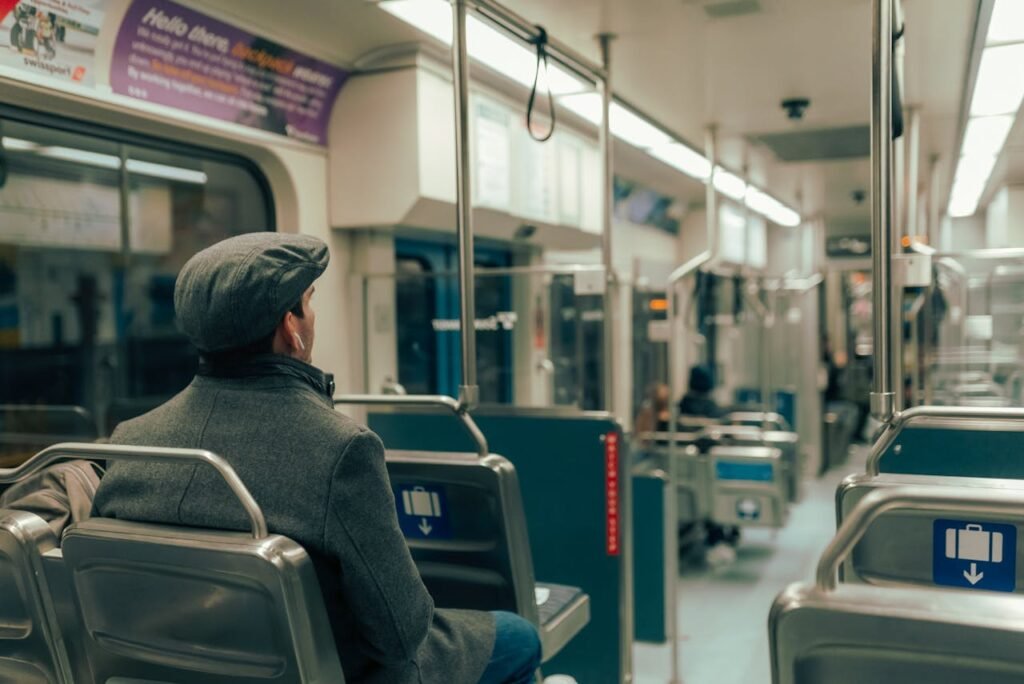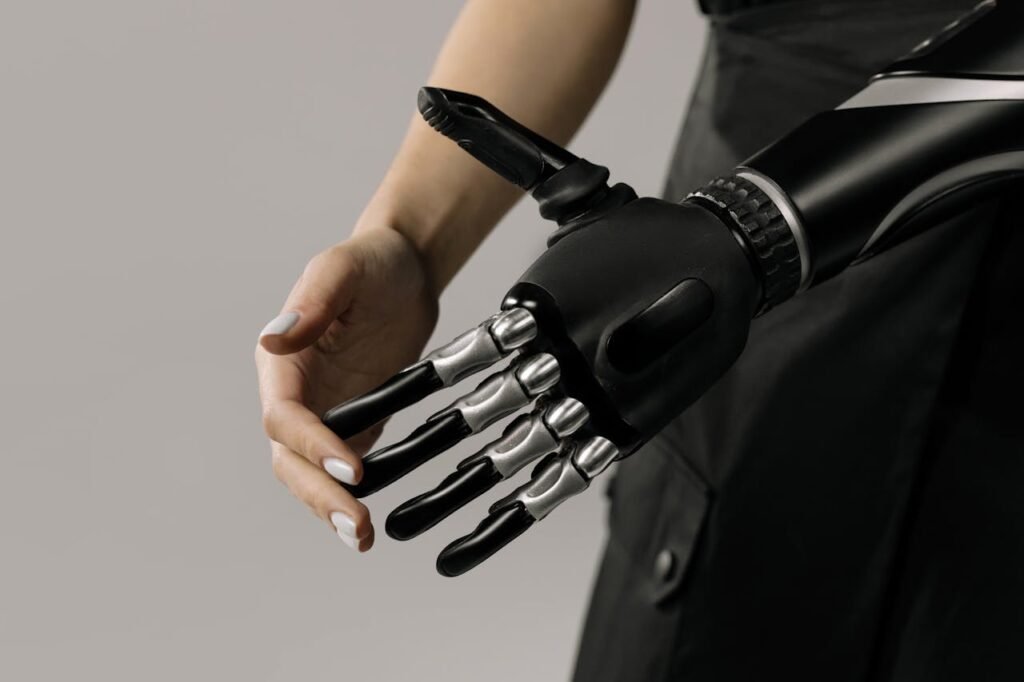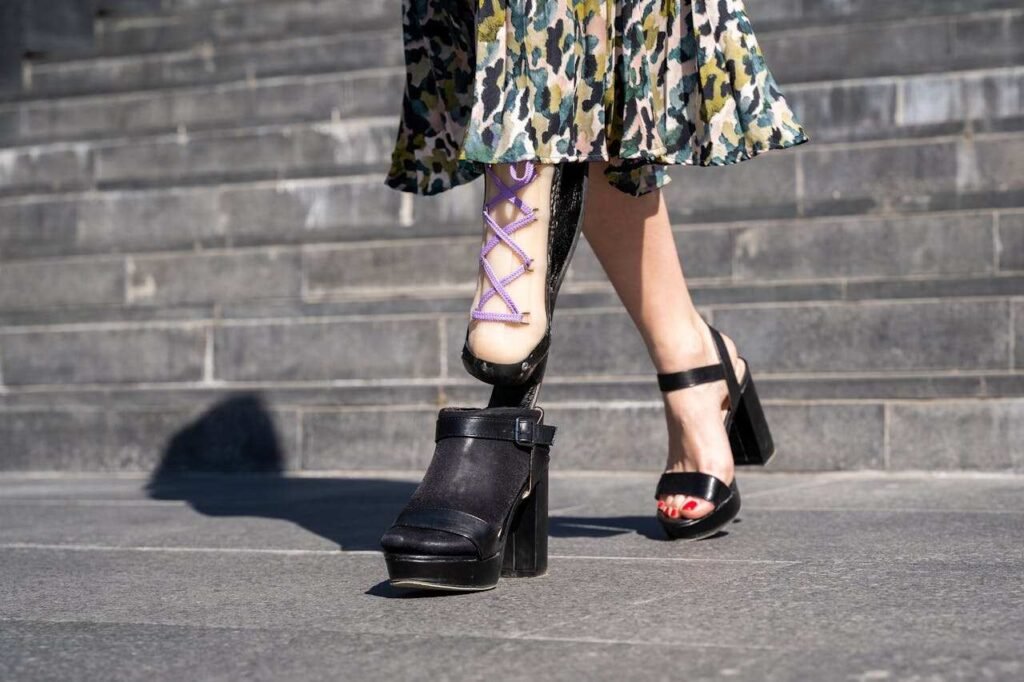Getting around in Indian cities is an adventure on its own—crowded metros, rushing buses, and noisy autos form part of daily life. For someone using a prosthetic hand, this journey can be both empowering and challenging. The prosthetic gives independence, but public transport often demands fast reactions, firm grips, and awareness that can be physically and mentally taxing.
Yet, with a few adjustments, confidence and safety can become second nature. Learning how to handle each mode of transport—how to hold railings, carry bags, tap smart cards, or signal autos—turns commuting into a comfortable routine rather than a daily stress.
At Robobionics, we’ve worked with hundreds of prosthetic users who rely on public transportation across cities like Delhi, Mumbai, Bengaluru, and Chennai. Their experiences have shaped valuable insights into how small techniques can make a big difference.
This article explores practical, real-world ways to stay safe and comfortable while commuting locally with a prosthetic hand—because independence isn’t just about moving from one place to another, it’s about moving with confidence and ease.
Preparing for the Commute – Everyday Readiness and Mindset
Building Confidence Before Stepping Out

Commuting with a prosthetic hand begins long before you step onto the road. The first step is confidence—believing that your prosthetic is not a limitation but a tool of independence.
Every prosthetic user has a different comfort level. Some can lift and grip strongly, while others are still getting used to balance and control. A short morning routine that checks your prosthetic’s fit, grip, and comfort sets a positive tone for the day.
Before leaving, flex your prosthetic hand a few times, check the wrist joint, and ensure straps or suction fits are tight but comfortable. Feeling secure about your prosthetic gives you calmness in crowded situations.
Planning Your Route
India’s local commute can be unpredictable—delays, crowd surges, or sudden rain are part of the experience. Planning ahead helps reduce stress and keeps your movements smoother.
If possible, check metro timings or bus routes online before heading out. Choose less-crowded time slots when you can. Early mornings and mid-afternoons are usually calmer.
For those new to prosthetic use, avoiding rush hours initially is a good idea. It helps you build confidence without physical strain. Once you’re used to handling small crowds, you’ll find larger ones easier to navigate.
Dressing for Safety and Ease
Clothing plays a subtle but important role in commuting safely. Choose outfits that give your prosthetic full movement without slipping or restricting.
Light, breathable fabrics work well, especially in hot weather. Sleeves that aren’t too tight help prevent friction around the socket area. For women, salwar kameez, kurtas, or sarees with elbow-length sleeves allow easy access if adjustments are needed.
For men, shirts with soft cuffs or half sleeves are ideal. Avoid loose ends or hanging bags that can catch onto railings or handles. The goal is to stay comfortable, unrestrictive, and ready for movement.
Managing Bags and Personal Items
Carrying bags can be tricky at first. Sling bags or crossbody styles work best because they keep your hands free. Adjust the strap so that it rests above the prosthetic elbow instead of across it.
Backpacks are also useful, especially if you’re traveling longer distances. Choose one with chest straps to keep it stable and light on your shoulders. Avoid holding heavy shopping bags in your prosthetic hand—they may strain the wrist or affect balance.
Distribute weight evenly, and use your natural hand for handling wallets, phones, or travel cards. The prosthetic can help with balance or light grip instead of constant lifting.
Preparing Mentally for Crowds
Crowds can feel overwhelming, especially during rush hours. The key is to stay calm, move steadily, and maintain awareness of your surroundings.
A prosthetic hand often draws curiosity from others, but it’s best to focus on your path, not on reactions. Crowds usually part when they see your confidence and pace.
If you ever feel uneasy, step aside for a few seconds, breathe deeply, and re-enter the flow when comfortable. The goal is smooth, stress-free movement rather than speed.
Checking Weather and Environment
Weather can affect your comfort while commuting. High humidity or rain can make prosthetic gloves slippery, while extreme heat may cause mild swelling of the residual limb.
Before leaving home, apply a light talcum powder around your skin interface for breathability. Carry a soft handkerchief or tissue to wipe your prosthetic if it gets wet or dusty.
During monsoon, keep a small waterproof pouch for your prosthetic’s battery (if myoelectric) or sensitive areas. Dry the socket and glove thoroughly once you’re indoors again.
Setting Expectations for the Day
Some days will be smooth, others more challenging—and that’s perfectly normal. Accepting that small setbacks may happen keeps frustration away.
Maybe a bus is too full, or an auto driver refuses a ride—these moments are temporary. The bigger picture is your growing independence. Each journey builds confidence and skill.
Instead of worrying about control, focus on adaptability. That mindset makes every commute easier and safer.
Traveling by Metro – Balance, Safety, and Accessibility Tips
Understanding the Metro Environment

The metro is one of the safest and most convenient public transport options for prosthetic users in India. It’s predictable, structured, and offers accessibility features that most buses and autos don’t.
However, the pace at which people move—especially during peak hours—can be intimidating at first. Escalators, automatic doors, and packed compartments require a good sense of balance and quick reaction.
The key is not to rush. Moving a few seconds slower is always safer than trying to match the crowd’s speed.
Choosing the Right Time to Travel
Metro crowds are at their heaviest between 8:30 to 10:00 a.m. and 6:00 to 8:00 p.m. If possible, plan your commute just before or after these rush hours. The extra space makes a big difference when you’re still adjusting to your prosthetic’s rhythm.
If you must travel during peak times, wait for the next train if the first one looks packed. You’ll save yourself unnecessary pushing or jostling. Even a two-minute delay can give you a calmer ride.
Using Escalators and Elevators
Escalators can be tricky but manageable with a little practice. Always hold the railing with your natural hand for stability. Keep your prosthetic close to your body rather than extended outward.
If your balance feels uncertain, or if the station is too crowded, use the elevators instead. Most metros in India—especially Delhi, Mumbai, Bengaluru, and Hyderabad—have designated lifts for people with disabilities.
Don’t hesitate to use them. They are meant for convenience, not special treatment. Safety and comfort always come first.
Ticketing and Entry Gates
Modern metros use contactless smart cards or tokens for entry. If your prosthetic is a myoelectric or body-powered model, you can easily hold and tap the card using your natural hand while your prosthetic supports balance.
If you carry a bag, keep your card in a front pocket or a holder attached to the bag strap for easy reach. Avoid fumbling at the gate since it causes unnecessary pressure from people behind.
At many stations, there are wider gates for passengers who may need extra space. You can ask the metro staff to open those gates if needed—they’re always cooperative when approached politely.
Boarding the Train
Always wait near the marked boarding area, usually indicated by tactile tiles or painted arrows. Stand slightly to the side of the door rather than directly in front. This allows passengers inside to exit easily before you step in.
Once inside, move toward the center of the compartment or stand near a pole. Use your natural hand for grip and keep the prosthetic free for balance. Some prosthetic users prefer standing sideways—this position provides better stability during acceleration and braking.
If seats are available, choose those closer to the door. Reserved seats for people with disabilities are usually at the ends of each coach.
Managing Balance While Standing
The metro’s smooth motion can still cause small jerks when it starts or stops. For better balance, keep your feet shoulder-width apart and slightly bend your knees.
Use your prosthetic hand to support light contact with a nearby pole or rail—it doesn’t need to hold tightly, just enough to maintain awareness of motion.
For women using sarees or long dresses, ensure the fabric doesn’t get caught in the joints of your prosthetic or under your feet. Tuck it slightly before stepping on the train.
Dealing with Crowded Coaches
Crowded metros can be stressful for anyone. For prosthetic users, the constant brushing and pushing can feel uncomfortable.
If you find yourself in a packed coach, position your prosthetic arm toward your side or front, never outward. This reduces the chance of accidental knocks.
You can also lightly cover your prosthetic with your dupatta, stole, or sleeve to prevent unwanted stares or contact. Small details like these help you move with calm and confidence.
Getting Off Smoothly
As the train approaches your station, move closer to the door one stop earlier. This gives you time to exit without rushing.
If the crowd is thick, use your natural hand to signal politely that you need space to pass. Most people will make room once they understand.
Once on the platform, step aside before adjusting your prosthetic or bag. Rushing increases the chance of imbalance, especially when people behind are in a hurry.
Handling Stairs and Platforms
After exiting, decide whether to take the lift, escalator, or stairs based on your energy and balance that day. Never feel pressured to use the stairs just because others are.
For stairs, always hold the railing with your natural hand and lead with your stronger leg first. Keep the prosthetic close to your torso to maintain balance.
If you’re using an escalator, keep both feet firmly planted, facing forward. When it reaches the top, step off confidently—hesitation causes imbalance.
Using Metro Facilities for Safety
Many metro stations now have tactile paths, wider gates, and accessible help desks. Use them freely. Metro staff are trained to assist passengers with prosthetics, wheelchairs, or visual impairments.
If you need extra help boarding or finding elevators, inform the nearest station attendant. They’ll often walk you through safely or guide you to the correct exit.
Some metros also have designated compartments for women and differently-abled passengers. These are usually less crowded, offering extra space and comfort.
Managing Bags and Belongings
When standing, keep your bag close to your front or side. Avoid hanging it behind your shoulder where it might hit others or shift your balance.
If you have to carry multiple items, hold the lighter ones in your prosthetic and heavier ones in your natural hand. For example, the prosthetic can carry a file or umbrella, while the other hand manages your phone or travel card.
This even distribution prevents fatigue and helps maintain posture during long rides.
Emotional Adjustment During Commute
Crowds and public spaces often bring mixed emotions. It’s natural to feel cautious or anxious, especially in the beginning. But over time, the metro can become your comfort zone—it’s predictable, clean, and structured.
You might notice curious glances from others. Don’t let them affect you. In fact, your confidence may inspire someone else in the crowd who’s silently struggling.
Each trip builds courage. Every station you cross is a reminder that you’ve mastered something many people hesitate to even try.
Traveling by Bus and Auto – Safety, Communication, and Practical Adaptation in Real Traffic Conditions
The Realities of Bus and Auto Travel in India

Unlike metros, buses and autos move through unpredictable traffic, uneven roads, and frequent stops. These rides demand quick reflexes, strong balance, and alertness.
For prosthetic users, especially those in busy cities like Delhi, Pune, or Chennai, these challenges can feel intimidating at first. But once you learn how to anticipate motion, communicate clearly, and position yourself safely, traveling by bus or auto becomes a routine part of life again.
Confidence grows with repetition. The more you travel, the more you’ll understand how your prosthetic interacts with movement and vibration.
Choosing the Right Bus or Auto
When possible, choose low-floor buses—they are easier to board, have wider steps, and often feature designated seating for people with disabilities. Conductors in public transport systems like BMTC, BEST, or DTC are generally helpful if you ask politely for assistance.
For autos, prefer those with stable footrests and cleaner interiors. You’ll have more space to adjust your seating position without discomfort. If the auto’s floor is slippery, ask the driver to place a cloth or mat for extra grip before sitting.
Small actions like these make a big difference in safety and comfort.
Boarding a Bus Safely
Approaching a moving bus can be dangerous, even for regular passengers. Always wait until the bus comes to a complete stop before stepping forward. Use your natural hand to grip the railing and keep your prosthetic arm close to your body.
If your prosthetic has a hook or fixed hand, make sure it doesn’t catch onto railings or other passengers’ clothes while boarding. Move slowly but steadily, placing your feet firmly on each step.
Once inside, move toward the seating area instead of standing near the door. Sudden starts can make balance difficult, especially on bumpy routes.
Finding a Comfortable Position
Choose a seat close to the door so you don’t need to walk through a crowded aisle. Side-facing seats allow better control over your prosthetic’s position and make it easier to support balance when the bus turns or brakes suddenly.
If you must stand, use your natural hand to hold a pole or handlebar. The prosthetic can be used for light contact or additional stability but shouldn’t bear the full weight.
Position your body slightly sideways to absorb movement better. This stance gives your legs a stronger foundation and keeps your balance centered.
Managing Crowded Conditions
Crowded buses are a reality in most Indian cities. During such times, personal space shrinks dramatically, making awareness crucial.
If people are pressing close, keep your prosthetic near your torso. Avoid lifting it above shoulder height in tight spaces—this helps prevent accidental bumps.
When you need to get off, inform the conductor one stop before your destination so they can make room for your exit. Passengers generally cooperate once they understand your need.
Handling Fares and Tickets
If your prosthetic hand doesn’t have fine grip control, it’s best to keep money or tickets in an easy-access pocket or pouch. Use your natural hand for exchange to avoid dropping coins or cards in crowded conditions.
Some cities have digital ticketing apps that let you pay through QR codes—these reduce physical handling altogether.
Keeping a few small notes ready instead of large bills saves time and effort during the ride.
Safety While Standing or Moving
City buses often stop abruptly or take sharp turns. When standing, slightly bend your knees and keep your prosthetic positioned toward the center aisle. This helps distribute force evenly and prevents sudden jerks from pulling on the socket.
If your prosthetic is a myoelectric model, switch it to passive mode if you’re not using active functions during the ride. It conserves battery and avoids accidental hand movements caused by vibration.
Be cautious about resting your prosthetic arm against windows or metal surfaces—they can get very hot under the sun and cause discomfort.
Getting Off the Bus
Plan your exit a stop early. Move closer to the door gradually so you don’t have to rush when the bus halts.
Use your natural hand for support when stepping down. Keep your prosthetic balanced to your side or front to maintain even posture. If the bus floor or step is wet, place your stronger foot first to test grip before fully descending.
Once you’re on the ground, step back to allow others space, then adjust your balance before moving away.
Traveling by Auto – Comfort and Safety Tips
Auto-rickshaws are a lifeline in Indian cities. They’re quick, accessible, and can take you directly to your destination. But their open design and unpredictable motion require some adjustment for prosthetic users.
When entering an auto, step in backward first, then pivot your body. This prevents the prosthetic from hitting the frame or mirror. Sit slightly sideways for better balance during turns.
If your prosthetic has movable fingers, keep them in a relaxed position to avoid unwanted vibration responses. If it’s a fixed hand, ensure it’s resting comfortably and not pressing into your lap or the sidewall.
Communicating with Drivers
Auto drivers respond well to clear communication. If you need them to drive slowly or avoid sudden jerks, explain politely before starting the ride. Most drivers are understanding once they know you’re using a prosthetic.
You can also request help with lifting small bags or adjusting the seat space. A brief explanation goes a long way in ensuring cooperation and comfort.
Handling Payment and Change
Always keep your wallet or phone within easy reach. Avoid deep pockets that require two hands to open. For safety, use mobile wallets or UPI for contactless payments. It’s faster and reduces the chance of dropping cash.
If you’re handing over money directly, use your natural hand. Keep the prosthetic relaxed to avoid unintentional strain while managing coins or notes.
Adapting to Auto Movements
Autos move unevenly through traffic. To keep balance, plant your feet firmly on the floor and slightly lean into turns. Your prosthetic can rest on your thigh or hold onto the seat edge lightly.
Avoid stretching your prosthetic arm outside the vehicle—it may hit other vehicles or obstacles. During sharp stops, press your back gently against the seat to absorb the motion.
Once you reach your destination, wait for the auto to stop completely before stepping out.
Protecting Your Prosthetic from Dust and Heat
Autos are open vehicles, so exposure to dust, sunlight, and pollution is common. A light sleeve or cover over your prosthetic helps prevent discoloration and keeps it clean.
During summer, metal components can heat up quickly. A thin cotton sleeve provides protection without trapping heat. In monsoon, a small waterproof wrap is useful to prevent moisture seepage into joints or electronics.
Always wipe the prosthetic gently with a soft cloth after the ride to remove dirt or sweat residue.
Handling Long-Distance or Intercity Travel
If you’re traveling longer distances by bus, plan rest intervals where you can remove your prosthetic briefly to relax your limb. Continuous vibration can cause mild fatigue or skin irritation.
Carry a small cleaning kit—soft wipes, powder, and socket liners—to refresh your prosthetic if the journey exceeds two hours.
Choose window seats or corner spaces with arm support whenever possible. This allows you to rest comfortably without straining the prosthetic joint.
Dealing with Unexpected Situations
Public transport often brings surprises—a sudden breakdown, crowded detour, or abrupt weather change. Staying calm is key.
If you need to disembark early due to discomfort, ask the driver to stop safely rather than trying to jump off quickly. If your prosthetic glove feels loose or damp, take a short break to fix it before continuing.
The best safety practice is patience. Rushing often causes more trouble than waiting.
Gaining Familiarity with Routes
After a few weeks, you’ll naturally discover which routes, drivers, or transport modes suit you best. You might prefer metros for speed, buses for economy, or autos for flexibility.
Keep mental notes of stations or stops with smoother boarding areas or less-crowded timings. Familiarity reduces stress and helps you navigate confidently.
Every successful ride strengthens your sense of independence and trust in your own capability.
Practical Adaptation, Emergency Readiness, and Building Confidence for Long-Term Mobility
Understanding Everyday Adaptation

Daily commuting with a prosthetic hand becomes effortless with practice, but it starts with observation. Each day brings new learnings—how your prosthetic reacts to heat, how it handles small vibrations, or how your balance shifts when standing on a moving vehicle.
The key is not perfection but adaptation. Notice how your prosthetic behaves in different environments and adjust your habits slightly each time. These tiny, mindful changes build lasting confidence.
Over time, you’ll stop thinking about every step. Your movements will become fluid and natural, just like before.
Creating a Comfortable Routine
Before leaving home, give yourself a few extra minutes to check the prosthetic’s alignment, comfort, and grip. Small discomforts in the morning can become major irritations during travel.
Keep the socket area clean and dry. If you use silicone liners, make sure they fit snugly and don’t cause sweating. A small packet of talcum powder in your bag helps manage humidity during long commutes.
Once this becomes habit, your daily preparation feels effortless, freeing you to focus on your destination rather than the journey.
Managing Fatigue and Posture
Commuting can be physically tiring even without a prosthetic. The combination of standing, balancing, and carrying bags increases fatigue over time.
Switch sides occasionally when holding bags. Alternate between your natural hand and prosthetic for lighter loads. This distributes weight evenly and reduces strain on your shoulder and back.
If you use public transport daily, practice gentle shoulder and arm stretches after your commute. These movements help prevent stiffness and improve blood flow to your residual limb.
Maintaining good posture—upright shoulders, relaxed neck, and slightly bent knees while standing—keeps you balanced and less fatigued.
Handling Slips, Jerks, and Sudden Stops
Indian traffic is unpredictable, and so are the vehicles. You may experience sudden stops or bumps on buses, autos, or even metros. The trick is to maintain an “alert but relaxed” stance.
When standing, keep your knees soft to absorb shocks. Hold rails firmly with your natural hand and let your prosthetic assist in balance. If you lose balance, shift your weight through your feet rather than pulling with your prosthetic arm.
Avoid locking your elbow or shoulder joint too tightly—it limits your body’s ability to absorb motion smoothly. Flexibility equals safety.
Emergency Readiness and Calm Response
Emergencies during travel can take many forms—crowded stampedes, sudden rain, power failures in the metro, or vehicle breakdowns. The best response is calm observation and slow action.
If you’re caught in a rush, protect your prosthetic arm by keeping it close to your torso. In case of heavy crowd push, turn sideways to minimize impact.
If your prosthetic becomes loose or detached, do not panic. Step aside to a safe area and fix it calmly. Many prosthetics, especially those made for daily wear, are built to withstand pressure and quick reattachment.
Carry a small emergency pouch containing cleaning wipes, a soft cloth, a liner, and a handkerchief. These small items come in handy if the prosthetic needs quick adjustment.
Navigating Rain, Heat, and Dust
Indian weather poses unique challenges—humid monsoons, dry dust in summer, and sudden downpours in the north. For prosthetic users, these conditions require simple preventive care.
During monsoon, use waterproof sleeves to protect your prosthetic’s joints and glove. If water seeps in, remove the prosthetic as soon as you reach a dry space and wipe it thoroughly.
In summer, avoid direct sunlight for long periods. Silicone surfaces can heat up and feel sticky. Carrying a small cotton cover helps keep your prosthetic cool and clean.
In dusty environments, gently clean the outer glove with a damp cloth at the end of the day. Dust buildup not only dulls appearance but may affect grip precision over time.
Adapting Technology for Commuting
If you use a myoelectric prosthetic, battery management is essential during long travel hours. Always ensure it’s fully charged before leaving. Most prosthetics last 8–12 hours per charge, but it’s wise to carry a small power bank if your system allows USB charging.
You can switch to passive mode during travel to conserve battery power. Once you reach your destination, reactivate active grip control as needed.
If you rely on body-powered models, periodically check cable tension and shoulder harness alignment. Continuous motion through crowds may loosen them slightly over weeks of use.
Communicating Needs Without Hesitation
One of the biggest strengths a commuter with a prosthetic can develop is communication. Informing others calmly about your needs not only ensures safety but also promotes awareness.
If you need a seat, don’t hesitate to ask. Most people are willing to help but may not realize you require support unless you tell them.
When entering crowded autos or buses, a simple line like “I use a prosthetic hand, please give me a moment to settle” helps others make space without awkwardness.
You deserve comfort and safety as much as anyone else on the road—and expressing that assertively is part of your independence.
Emotional Resilience in Daily Commute
Some days may feel harder—uncomfortable stares, lack of space, or fatigue can test patience. Emotional strength plays a huge role in how smoothly you adapt.
The first few weeks of public commuting after getting a prosthetic are often emotionally charged. It’s a process of rediscovery—how your body moves, how people react, and how you fit into your environment again.
Celebrate small victories. Every ride completed without struggle is progress. Every moment of calmness in chaos is confidence earned.
Instead of focusing on what’s different, remind yourself how much you’ve accomplished already. You’re not just traveling—you’re reclaiming freedom, one ride at a time.
Social Awareness and Helping Others Understand
Public curiosity about prosthetics is normal in India, where awareness is still growing. You may find people asking questions or staring out of interest rather than judgment.
When you feel comfortable, take these opportunities to educate gently. A few calm words can change how someone perceives prosthetic users for life.
If you’re not in the mood to explain, a polite smile or short nod is enough. Remember, awareness starts with visibility—your presence on public transport normalizes assistive technology for everyone.
Adapting to Different Cities
Commuting experiences vary widely between Indian cities. Delhi’s metros are structured, Mumbai’s locals are fast, and Bengaluru’s buses are friendly but crowded.
The best approach is to spend the first few days observing before diving into peak-hour travel. Note platform designs, door timings, or auto stand behavior. Each city has its rhythm, and once you catch it, everything feels easier.
If you move cities frequently, inform your prosthetist. They can adjust your socket or glove texture for different climates—humid Chennai needs breathability, while dry Ahmedabad benefits from moisture control.
Traveling for Work and Office Routines
Office commutes require consistency. Choose routes that offer predictability even if they take a few minutes longer. Regularity builds routine, and routine builds comfort.
At workplaces, keep a small prosthetic care kit at your desk—extra liners, wipes, and a sleeve. A two-minute check mid-day ensures comfort for the ride back home.
If your job involves field visits or client meetings, inform colleagues about accessibility needs in advance. They’ll often accommodate your travel pace or assist during transitions.
Self-Care After Long Commutes
At the end of a busy day, it’s easy to forget that your body—especially the residual limb—needs care too. Remove your prosthetic once you’re home and clean both your skin and socket gently.
Check for any redness or marks. These are early signs of friction that can be fixed with minor adjustments.
A short massage or applying a soothing lotion helps relax muscles and keep the skin healthy. Over time, this becomes a relaxing ritual after every long commute.
Building a Community of Support
Connecting with other prosthetic users, either online or through rehabilitation centers, can make a big difference. Sharing commute experiences, small hacks, and travel tips makes learning faster and more enjoyable.
At Robobionics, many users tell us they gained the most confidence by observing others—how they board trains, carry bags, or use autos creatively. Seeing real people handle similar challenges proves that comfort and confidence are entirely achievable.
You’re never alone in this journey. There’s a community growing every day, reshaping what accessibility looks like in India.
Embracing Independence Fully
True independence isn’t about avoiding challenges—it’s about navigating them with skill and peace. Once you’ve mastered local commuting, you’ll realize your prosthetic is no longer something to manage—it’s simply part of you.
You’ll hail an auto without hesitation, balance in a crowded metro effortlessly, and even handle a rainy-day bus ride with calm precision.
The small moments—tapping your metro card, carrying your bag, or signaling a driver—become reminders of how far you’ve come. Each one reinforces your freedom and confidence.
Looking Ahead – Safer, Smarter Commutes
Technology and awareness are advancing fast in India. Metro networks continue expanding, buses are becoming more accessible, and prosthetic design itself is evolving.
Future prosthetics will likely integrate sensors that improve grip during vehicle motion or detect balance shifts automatically. As cities modernize, your travel experience will only become smoother.
Robobionics continues to innovate with real users in mind—developing prosthetics designed not just for motion, but for Indian lifestyles, fabrics, weather, and transport habits.
The goal is simple: complete freedom of movement, wherever you go.
Final Thoughts
Local commuting with a prosthetic hand isn’t about overcoming obstacles—it’s about redefining normal life with courage and creativity. Every metro ride, every bus stop, every auto journey becomes proof that mobility is not just possible but empowering.
You adapt, learn, and eventually move without second thought—because comfort comes not from perfection but from familiarity.
At Robobionics, we believe independence begins with motion. The prosthetic is not a barrier; it’s a bridge—to opportunity, connection, and confidence.
Whether you’re rushing to work, meeting friends, or simply exploring your city, remember this—your prosthetic doesn’t define your journey. You do.



